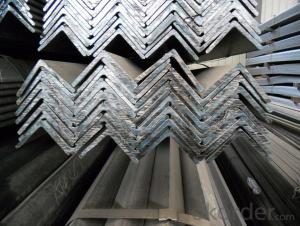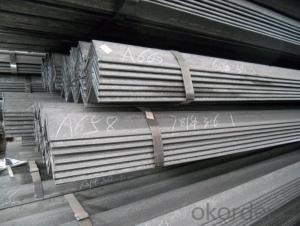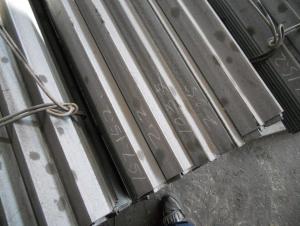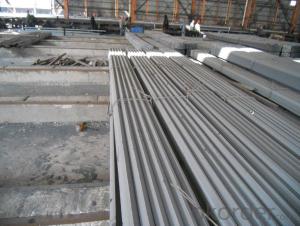Hot Rolled Equal Angle Steel with High Quality
- Loading Port:
- Tianjin
- Payment Terms:
- TT OR LC
- Min Order Qty:
- 20 m.t.
- Supply Capability:
- 1000 m.t./month
OKorder Service Pledge
OKorder Financial Service
You Might Also Like
Product Description:
OKorder is offering Hot Rolled Carbon Steel Equal Angle at great prices with worldwide shipping. Our supplier is a world-class manufacturer of steel, with our products utilized the world over. OKorder annually supplies products to European, North American and Asian markets. We provide quotations within 24 hours of receiving an inquiry and guarantee competitive prices.
Product Applications:
According to the needs of different structures, Angle can compose to different force support component, and also can be the connections between components. It is widely used in various building structures and engineering structures such as roof beams, bridges, transmission towers, hoisting machinery and transport machinery, ships, industrial furnaces, reaction tower, container frame and warehouse etc.
Product Advantages:
OKorder's Equal Angle are durable, strong, and resist corrosion.
Main Product Features:
· Premium quality
· Prompt delivery & seaworthy packing (30 days after receiving deposit)
· Corrosion resistance
· Can be recycled and reused
· Mill test certification
· Professional Service
· Competitive pricing
Product Specifications:
1. Invoicing on theoretical weight or actual weight as customer request
2. Length: 6m, 9m, 12m as following table
3. Sizes

Sizes: 25mm-250mm | ||
a*t | ||
25*2.5-4.0 | 70*6.0-9.0 | 130*9.0-15 |
30*2.5-6.6 | 75*6.0-9.0 | 140*10-14 |
36*3.0-5.0 | 80*5.0-10 | 150*10-20 |
38*2.3-6.0 | 90*7.0-10 | 160*10-16 |
40*3.0-5.0 | 100*6.0-12 | 175*12-15 |
45*4.0-6.0 | 110*8.0-10 | 180*12-18 |
50*4.0-6.0 | 120*6.0-15 | 200*14-25 |
60*4.0-8.0 | 125*8.0-14 | 250*25 |
Packaging & Delivery of Angle Steel
1. Packing: it is nude packed in bundles by steel wire rod
2. Bundle weight: not more than 3.5MT for bulk vessel; less than 3 MT for container load
3. Marks:
Color marking: There will be color marking on both end of the bundle for the cargo delivered by bulk vessel. That makes it easily to distinguish at the destination port.
Tag mark: there will be tag mark tied up on the bundles. The information usually including supplier logo and name, product name, made in China, shipping marks and other information request by the customer.
If loading by container the marking is not needed, but we will prepare it as customer request.
Production flow of Angle Steel
Material prepare (billet) —heat up—rough rolling—precision rolling—cooling—packing—storage and transportation
FAQ:
Q1: Why buy Materials & Equipment from OKorder.com?
A1: All products offered byOKorder.com are carefully selected from China's most reliable manufacturing enterprises. Through its ISO certifications, OKorder.com adheres to the highest standards and a commitment to supply chain safety and customer satisfaction.
Q2: How do we guarantee the quality of our products?
A2: We have established an advanced quality management system which conducts strict quality tests at every step, from raw materials to the final product. At the same time, we provide extensive follow-up service assurances as required.
Q3: How soon can we receive the product after purchase?
A3: Within three days of placing an order, we will begin production. The specific shipping date is dependent upon international and government factors, but is typically 7 to 10 workdays.
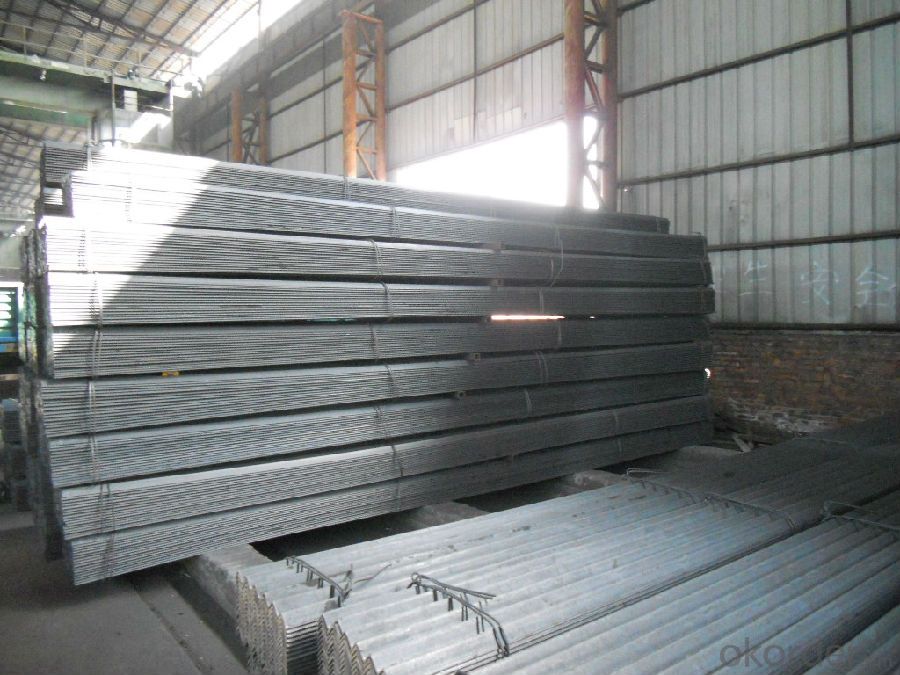
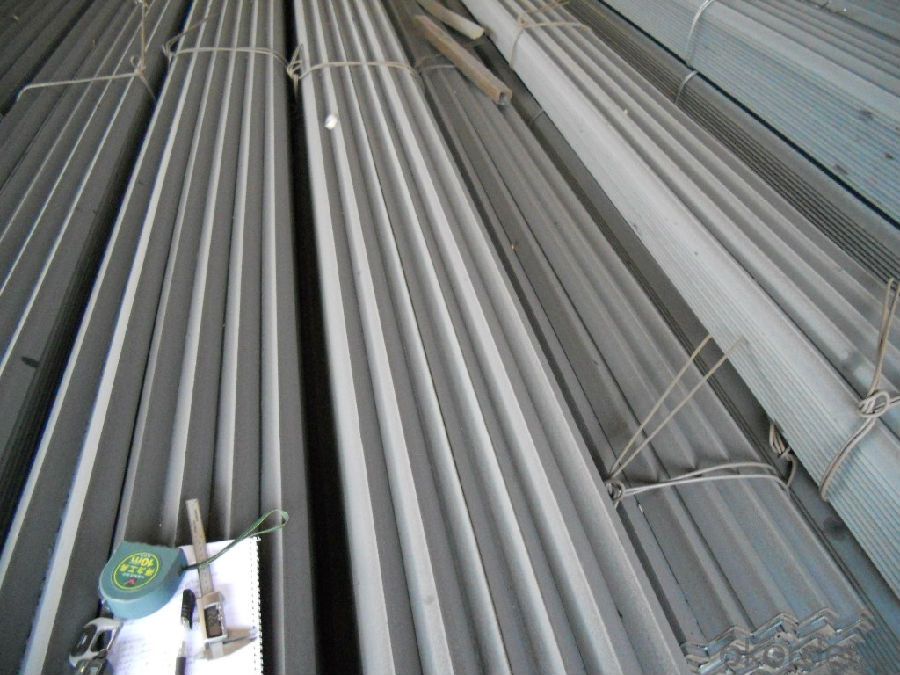
- Q:How are steel angles tested for quality and strength?
- Steel angles are tested for quality and strength through various methods, including visual inspection, measurement of dimensions, and mechanical testing. Visual inspection involves checking for any visible defects or imperfections such as cracks, surface irregularities, or rust. Measurement of dimensions ensures that the angles meet the specified size and shape requirements. Mechanical testing involves subjecting the angles to forces or loads to determine their strength, such as tensile testing to measure their resistance to pulling or bending, and hardness testing to assess their resistance to indentation. These tests help ensure that steel angles meet the desired quality and strength standards.
- Q:What is the process of galvanizing steel angles?
- To protect steel angles from corrosion, the galvanizing process encompasses multiple steps. Initially, the angles undergo a thorough cleaning process to eliminate any dirt, oil, or rust on the surface. This is achieved through pickling, wherein the angles are immersed in a solution of acid, usually hydrochloric acid, to eliminate impurities. Subsequently, the cleaned steel angles are rinsed to eliminate any remaining acid and are then dried meticulously. This step is crucial to ensure proper adhesion of the zinc coating. Following the cleaning process, the steel angles are immersed in a bath containing molten zinc. This is known as hot-dip galvanizing, where the angles are completely submerged in the zinc bath. The temperature of the bath typically reaches around 840°F (449°C). While the steel angles are immersed in the zinc bath, a metallurgical reaction occurs between the molten zinc and the steel. Consequently, a layer of zinc-iron alloy is formed on the surface of the angles. This layer offers exceptional resistance against corrosion and acts as a barrier between the steel and the corrosive elements present in the environment. Once the angles have been fully immersed in the zinc bath, they are removed and allowed to cool. The cooling process solidifies the zinc coating and ensures its adherence to the steel angles. Finally, the galvanized steel angles undergo a comprehensive inspection to ensure quality control. This involves examining the thickness, uniformity, and adherence of the coating to the angles. Various tests and measurements are conducted to verify that the galvanized coating meets the required standards and specifications. Overall, the galvanizing process for steel angles involves cleaning, immersion in a molten zinc bath, cooling, and inspection. This process yields a robust and long-lasting protective coating on the steel angles, enhancing their resistance to corrosion and extending their lifespan.
- Q:Can steel angles be used as framing members for suspended ceilings?
- Yes, steel angles can be used as framing members for suspended ceilings. They provide structural support and stability to hold the ceiling tiles or panels in place.
- Q:How do steel angles contribute to the resiliency of a structure?
- Steel angles contribute to a structure's resiliency in multiple ways. Firstly, they distribute the load across different members, providing added structural support and stability. In construction projects, steel angles are often used as reinforcements or braces, enabling the transmission of forces and preventing excessive deflection or deformation. This helps the structure resist external forces like wind, earthquakes, or heavy loads, ultimately enhancing its overall resilience. Furthermore, steel angles possess high durability and corrosion resistance, further bolstering a structure's resiliency. Steel, as a material, boasts exceptional strength and longevity, making it particularly well-suited for enduring harsh environmental conditions and potential structural failures. This durability ensures the structure can withstand the test of time, reducing the need for frequent repairs or replacements and ultimately improving its overall resilience. Additionally, steel angles offer flexibility in design and construction, facilitating efficient load transfer and optimized structural configurations. They can be easily customized and fabricated to meet specific project requirements, guaranteeing the structure can be tailored to withstand various dynamic and static loads. This adaptability enhances the structure's resiliency by enabling it to adapt to changing conditions or future modifications. In summary, steel angles play a vital role in enhancing a structure's resiliency by providing additional support, durability, and flexibility. Their ability to distribute loads, resist external forces, and withstand harsh conditions ensures the structure can withstand unexpected events and maintain its integrity. As such, steel angles are an indispensable component of resilient construction practices.
- Q:What are the different types of steel angles used in manufacturing?
- There are several different types of steel angles used in manufacturing, each with its own unique characteristics and applications. Some common types include: 1. Equal Angle: This type of steel angle has equal sides and angles, forming a 90-degree angle. It is commonly used for structural applications, such as framing and supports, where strength and stability are important. 2. Unequal Angle: As the name suggests, this type of steel angle has unequal sides and angles. It is often used for applications that require varying load-bearing capacities or to create different shapes in manufacturing processes. 3. L-Angle: Also known as L-shaped angles, this type of steel angle has a 90-degree bend with unequal sides. It is commonly used for reinforcing corners, as well as in construction and fabrication projects. 4. T-Angle: T-angles have a T-shaped cross-section, with one side extending vertically and the other extending horizontally. They are often used as structural supports or in applications where additional strength and rigidity are needed. 5. Flat Bar Angle: This type of steel angle has a flat surface on one side and a right-angle bend on the other. It is commonly used for bracing, supports, and framing in manufacturing and construction projects. 6. Slotted Angle: Slotted angles have holes or slots along their length, allowing for easy adjustment and customization. They are often used for shelving, racks, and storage systems in manufacturing and warehouse environments. These are just a few examples of the different types of steel angles used in manufacturing. The specific type of angle chosen will depend on the requirements of the project, including load-bearing capacity, structural integrity, and the desired shape or configuration.
- Q:Can steel angles be fire-resistant?
- Indeed, steel angles possess fire-resistant qualities. Being a material, steel inherently possesses fire resistance due to its high melting point and low thermal conductivity. When faced with elevated temperatures, steel angles can retain their structural integrity and withstand deformation for a significant duration. Furthermore, fire resistance in steel angles can be augmented through diverse approaches, such as the utilization of fire-resistant coatings or the integration of fire-resistant materials in their design. These measures serve to heighten the fire resistance capacity of steel angles, rendering them appropriate for scenarios where fire protection is imperative, such as the establishment of fire-resistant walls, ceilings, and structural systems in construction projects.
- Q:Are steel angles suitable for mezzanine floors?
- Yes, steel angles are suitable for mezzanine floors. Steel angles are commonly used in the construction of mezzanine floors due to their strength, durability, and cost-effectiveness. They provide structural support and stability, allowing for the creation of additional floor space. Steel angles can be easily fabricated and installed, making them a popular choice for mezzanine floor construction. They can withstand heavy loads and provide a stable platform for various applications such as storage, offices, or additional workspace. Additionally, steel angles can be customized to fit specific design requirements, making them a versatile option for mezzanine floor construction.
- Q:What are the different surface treatments for steel angles?
- Some common surface treatments for steel angles include galvanizing, painting, powder coating, and plating.
- Q:What are the common welding techniques used for steel angles?
- The common welding techniques used for steel angles include MIG (Metal Inert Gas) welding, TIG (Tungsten Inert Gas) welding, and stick welding (Shielded Metal Arc Welding - SMAW). MIG welding, also known as GMAW (Gas Metal Arc Welding), is a widely used technique that involves feeding a continuous wire electrode into the weld pool while an inert gas, such as argon or a mixture of argon and carbon dioxide, is used to shield the weld zone from atmospheric contamination. MIG welding is known for its ease of use, high welding speeds, and ability to handle thicker materials. TIG welding, also known as GTAW (Gas Tungsten Arc Welding), is a more precise welding technique that uses a non-consumable tungsten electrode to create the arc and a separate filler material if necessary. TIG welding provides excellent control over the weld pool and produces high-quality welds with minimal spatter. It is commonly used for thinner materials and applications that require a higher level of precision. Stick welding, also known as SMAW (Shielded Metal Arc Welding), is a versatile and widely used welding process. It involves striking an arc between a flux-coated electrode and the workpiece, creating a weld pool that is protected by the flux coating. Stick welding is known for its portability and ability to handle various materials and thicknesses. It is commonly used in construction, maintenance, and repair work. These welding techniques can be used for steel angles, which are often found in structural applications, such as frames, braces, and supports. The selection of the welding technique depends on factors such as the thickness of the steel angle, the required weld quality, and the specific application. It is important to consider the welding process, proper joint preparation, and welding parameters to ensure a strong and durable weld joint.
- Q:Can steel angles be used in agricultural or farm applications?
- Steel angles have the capability to be used in agricultural or farm applications. They are structural components that possess versatility and durability, making them a common choice in numerous industries, including agriculture. They find utility in farm equipment like machinery frames, trailers, and fences. The reason they are perfect for these uses is because of their strength and stability, allowing them to endure heavy loads and harsh weather conditions. Moreover, they can be easily customized and constructed for various agricultural structures by welding, bolting, or fastening them together. In summary, steel angles are a dependable and pragmatic option for agricultural and farm applications.
1. Manufacturer Overview |
|
|---|---|
| Location | |
| Year Established | |
| Annual Output Value | |
| Main Markets | |
| Company Certifications | |
2. Manufacturer Certificates |
|
|---|---|
| a) Certification Name | |
| Range | |
| Reference | |
| Validity Period | |
3. Manufacturer Capability |
|
|---|---|
| a)Trade Capacity | |
| Nearest Port | |
| Export Percentage | |
| No.of Employees in Trade Department | |
| Language Spoken: | |
| b)Factory Information | |
| Factory Size: | |
| No. of Production Lines | |
| Contract Manufacturing | |
| Product Price Range | |
Send your message to us
Hot Rolled Equal Angle Steel with High Quality
- Loading Port:
- Tianjin
- Payment Terms:
- TT OR LC
- Min Order Qty:
- 20 m.t.
- Supply Capability:
- 1000 m.t./month
OKorder Service Pledge
OKorder Financial Service
Similar products
New products
Hot products
Related keywords
